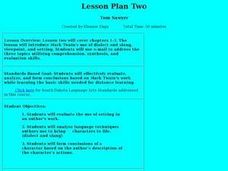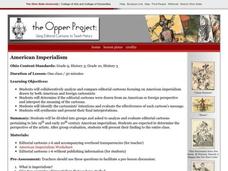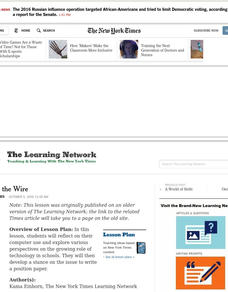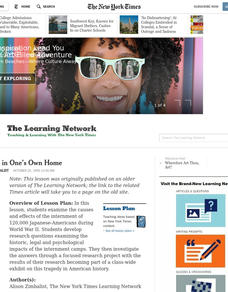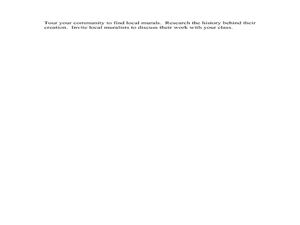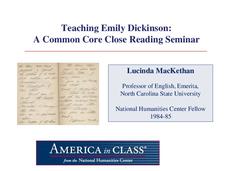Curated OER
Lessons in Looking: Contraband in Paintings
Using the paintings On to Liberty and A Ride for Liberty, 10th graders analyze historical perspectives on life after the Civil War. They attempt to determine what the Civil War meant for free slaves, then read a paragraph highlighting...
Curated OER
Validating Votes
Explore the discrepancies in Florida's vote counting process in 2000 and 2002 with this New York Times reading instructional activity. Middle schoolers study the viewpoints presented in informational text, paying attention to how...
Curated OER
Tom Sawyer
This lesson plan kicks off with a PowerPoint presentation on Mark Twain. Learners examine the dialect, slang, viewpoint and setting. Then use e-mail to address three topics utilizing comprehension, synthesis, and evaluation skills.
Curated OER
Finding Our Way Home: Immigration to the United States, 1815-1860
Students break into families of 4 members. They brainstorm issues that they would encounter as an immigrant family by creating a web. Students are given roles to research focusing on that perspective: father, mother, grandparent, and child.
Curated OER
Using an Author's Clever Strategies in One's Own Writing
Students examine specific clever strategies of the author and incorporate them in their own writings. They emulate Storti's strategies in writing an arresting lead and share their pieces in a class discussion, allowing them to critique...
Curated OER
American Imperialism
Critical analysis skills can be built in a variety of ways. Using editorial cartoons (both domestic and foreign) learners will consider how American Imperialism was perceived during the late 19th century. Critical thinking questions,...
Curated OER
"I Hear America Singing": Controversy and Music in the Mexican War
Eighth graders examine the Mexican War and its outcome through music. In this primary source analysis lesson, 8th graders analyze the lyrics of selected songs to consider the 2 perspectives regarding U.S. involvement in the war. Students...
Curated OER
Are We Safer?
Young scholars discuss the meaning of feeling safe in their environment after September 11th. After reading National Intelligence reports and news articles summarizing the findings about national security, they write letters to their...
Curated OER
A Whale of a Problem
Students evaluate the possible causes contributing to the decline of the killer whale population from a number of differing perspectives. They present their findings in a talk show format and in letters of advocacy regarding
Curated OER
Occupational Oxymoron
Students consider their own notions of poverty, examine the life of a woman classified as "working poor" from a variety of perspectives, and present their findings to the class. Then, students synthesize their knowledge in a paper.
Curated OER
Thanksgiving Mourning
Young scholars examine the way diverse groups can perceive a shared experience in a dramatically different light. Students read commentary written by Native American writers and find examples of different points of view. ...
Curated OER
Lesson One: The Three Perspectives on Native American Removal
Eleventh graders explore the impact of the Indian Removal Act. In this US History lesson, 11th graders analyze primary resources.
Curated OER
Down to the Wire
Students reflect on their computer use and explore various perspectives on the growing role of technology in schools. They develop a stance on the issue to write a position paper.
Curated OER
Westmoreland Trail
Seventh graders complete a unit of lessons on the Westward expansion of the U.S. They play the computer game, Oregon Trail III, read primary source documents, conduct Internet research, write diary entries from the pioneer viewpoint, and...
Curated OER
Pig Products
How do you feel about cloning? This issue is highly debated, so educate your class before they participate in a similar debate! Read a New York Times article related to the use of cloned pig organs for human transplants. Groups develop...
Annenberg Foundation
Electoral Politics
You won't just get a lesson when you click on this resource. As you click on the related resources located to the left of the screen, you'll find, a professional development video, teacher/student notes, lesson plan, and related...
Curated OER
Information Overload: Looking at News
How do events reported in mainstream newspapers, on television news, blog posts, and social network sites differ? Ask your class to investigate the way the same news item is presented in the many information sources available. Groups...
National WWII Museum
Dr. Seuss and WWII
What famous children's author and illustrator created World War II political cartoons featuring such subjects as fascism, the war effort, discrimination, and the dangers of isolationism? The who in this story is Dr. Seuss, and what...
Curated OER
Prisoner in One's Own Home
Examine the internment of Japanese-Americans during World War II. After reading an article from the New York Times and exploring the author's word choice, young readers find the central idea in the text and work on researching...
Curated OER
Murals: Historic Walls
Students examine Mexican history in murals. In this visual arts lesson, students research the artistic style of Mexican murals and the artists that create them. Students then present their research findings to their classmates and write...
Curated OER
Tango Stories
Young scholars listen to tango music and research the country it came from. In this music lesson, students find that tango music comes from Argentina. They listen and dance to the music and then write stories.
Curated OER
Touring the World With Tomie dePaola
Pupils listen aloud to books by Tomie dePaola. They utilize the Internet to study the geography and culture of the places the they read about in Tomie dePaola's books. They answer questions about Norway through an Internet treasure hunt.
Indiana University Libraries
Web Page Evaluation
Invite your learners to research three different websites that pertain to a topic focused on in your syllabus. Students fill out a chart by answering questions about each site. Then, they compare how useful the sites are to one...
National Humanities Center
Teaching Emily Dickinson: A Common Core Close Reading Seminar
Three of Emily Dickinson's poems, "I like to see it," "Because I could not stop for Death," and "We grow accustomed to the Dark," provide instructors with an opportunity to model for class members how to use close reading strategies to...




